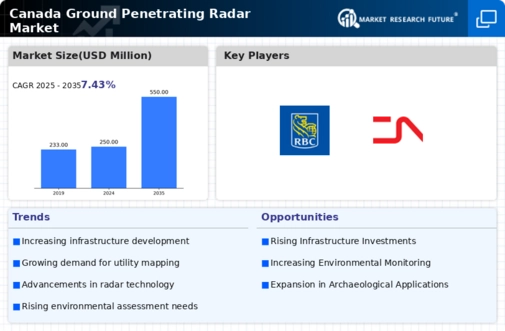Advancements in GPR Technology
Technological advancements in ground penetrating-radar systems are propelling the market forward in Canada. Innovations such as improved data processing algorithms, enhanced imaging capabilities, and the integration of artificial intelligence are making GPR more efficient and user-friendly. These advancements allow for faster data acquisition and more accurate subsurface imaging, which is crucial for various applications, including construction, archaeology, and environmental monitoring. As of 2025, the market is witnessing a surge in demand for advanced GPR systems, with a projected growth rate of 12% annually. This trend indicates that the ground penetrating-radar market is evolving rapidly, driven by the need for more sophisticated and reliable subsurface investigation tools.
Growing Applications in Construction
The construction sector in Canada is increasingly recognizing the value of ground penetrating-radar technology. GPR is utilized for various applications, including site assessments, utility mapping, and detecting voids or anomalies beneath the surface. As construction projects become more complex, the need for accurate subsurface information is paramount. The ground penetrating-radar market is expected to expand as construction companies adopt GPR to mitigate risks and enhance project efficiency. In 2025, it is anticipated that the construction industry will contribute significantly to the market's growth, with an estimated increase of 20% in GPR usage for construction-related applications. This trend underscores the importance of GPR in modern construction practices.
Increased Infrastructure Development
The ongoing infrastructure development in Canada is a crucial driver for the ground penetrating-radar market. With the government investing heavily in transportation, utilities, and urban development, the demand for non-invasive subsurface investigation techniques is rising. Ground penetrating radar (GPR) is increasingly utilized for locating utilities, assessing soil conditions, and ensuring the integrity of existing structures. In 2025, the Canadian government allocated approximately $10 billion for infrastructure projects, which is expected to boost the ground penetrating-radar market significantly. This investment not only enhances public safety but also minimizes disruption during construction activities, making GPR an essential tool in the planning and execution of infrastructure projects.
Environmental Concerns and Sustainability
Growing environmental concerns in Canada are driving the adoption of ground penetrating-radar technology. As industries and governments seek to minimize their ecological footprint, GPR offers a non-invasive alternative for subsurface exploration. This technology aids in environmental assessments, contamination detection, and remediation planning without disturbing the ground. The Canadian government has emphasized sustainable practices, leading to an increased focus on technologies that align with environmental regulations. The ground penetrating-radar market is likely to benefit from this trend, as organizations prioritize eco-friendly solutions. In 2025, it is estimated that the market could grow by 15% due to heightened awareness of environmental issues and the need for sustainable practices.
Regulatory Compliance and Safety Standards
Regulatory compliance and safety standards in Canada are increasingly influencing the ground penetrating-radar market. As industries face stricter regulations regarding subsurface investigations, GPR technology becomes essential for ensuring compliance with safety and environmental standards. The Canadian government has implemented various regulations that mandate the use of non-invasive methods for subsurface exploration, particularly in urban areas. This regulatory landscape is likely to drive the adoption of GPR technology, as organizations seek to adhere to these standards while minimizing risks. In 2025, the market is projected to grow by 10% due to the heightened emphasis on regulatory compliance, making GPR a vital tool for industries operating in regulated environments.












Leave a Comment